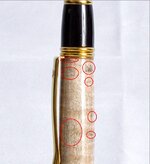jpford
Member
Hello all, I'm having an intermittent problem with sanding/finishing turned pen blanks. Every so often, I get what seem to be "dirty checks" in a turned piece. I usually turn with sharp tools and sand with 150,240,320, 400. I then use micro-mesh up to 12000. I'm doing both rotational and grain sanding. I also wipe the piece between grits.
The dirty checks seems to happen mostly with light colored woods, curly maple comes to mind. They are not throughout the turned piece, but scattered in no particular pattern. They look like dirt or metal filings have been incorporated into sanding scratches at some point in the process. they simply won't come out, no matter what I do. I've tried to resand, but they will not come out, as if they are impregnated into the wood deeply. I'm sure I'm doing something wrong, but I can't figure out what it is. Are these bad blanks, heat checks from hot drilling, or are they a bad sanding practice?
I'll try to find a picture of what I'm talking about , but I'd appreciate any help if you've seen this before.
Joel
The dirty checks seems to happen mostly with light colored woods, curly maple comes to mind. They are not throughout the turned piece, but scattered in no particular pattern. They look like dirt or metal filings have been incorporated into sanding scratches at some point in the process. they simply won't come out, no matter what I do. I've tried to resand, but they will not come out, as if they are impregnated into the wood deeply. I'm sure I'm doing something wrong, but I can't figure out what it is. Are these bad blanks, heat checks from hot drilling, or are they a bad sanding practice?
I'll try to find a picture of what I'm talking about , but I'd appreciate any help if you've seen this before.
Joel

